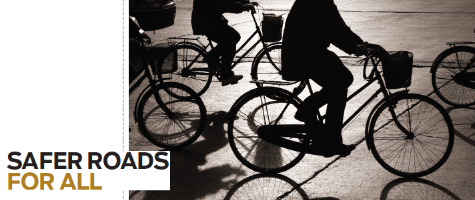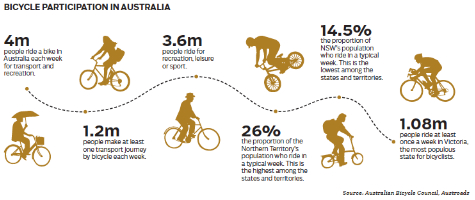A report commissioned late last year has suggested various recommendations to make high-speed roads safer for cyclists.
By Cyndi Tebbel
The benefits of riding a bicycle are undeniable. Cycling improves fitness, reduces travel times, saves money, connects riders to their surroundings – and it’s fun!

More cyclists on Australian roads would also ease traffic congestion in urban areas, reduce carbon emissions and noise, and create a healthier community.
Australians are taking to two-wheeled travel in increasing numbers, but only around two per cent of capital city residents use a bike to commute. That’s well below European cities like Amsterdam and Copenhagen, where more than a third of the population ride to work.
A recent survey by the Centre for Accident Research and Road Safety-Queensland (CARRS-Q) suggests that “fear of collision with motorised traffic” is a major reason cyclists aren’t taking to the roads in greater numbers. CARRS-Q states that the level of risk is low and outweighed by the health benefits, but instances of “near collisions” could be behind the exaggerated levels of fear.
Reducing risk
Providing safer road networks is key to allaying cyclist’s fears of collision. That’s the aim of a new joint report by the Australian Bicycle Council (ABC) and Austroads. Cycling on Higher-Speed Roads investigates the provision of facilities for bicycles on sealed roads with speed limits of 70 kilometres per hour or more, outlining options for improving urban and country roads for cyclists.
The report focuses on the engineering techniques that will help “reduce the inherent conflict” between cyclists and other motorists “to more acceptable levels”.
Some of these include:
• providing an alternative route, such as an off-road path or an alternative lower-speed route;
• providing space on-road;
• reducing the speed limit, and;
• using non-infrastructure solutions, such as technology and advertising campaigns (for example, real-time information may be provided to alert drivers that a cyclist is present).
Eleana Gardner, Executive Officer, Australian Bicycle Council, says the report will be influential in changing Austroads Guides, which provide nationally consistent road management and safety advice for road authorities across Australia.
Since its release in July 2012, the report has attracted a broad range of responses from cyclists. “Different cyclists want different types of infrastructure, so the report probably won’t influence new riders to start commuting on the shoulder lane of a 70-kilometre-per-hour road,” says Gardner.
“But we know that the greatest road safety benefit is giving cyclists off-road pathways to separate them from high-speed vehicles. That’s not always possible or economically feasible, especially over long distances and where demand is low, but there are things you can do.”

Planning considerations
Commenting on the report, a spokesperson from the NSW Roads and Maritime Service (RMS) noted that off-road alternatives and/or routes along lower-speed roads would increase cycling safety. For public works professionals, planning requires an “understanding of the type of cyclists who will use the site, continuity requirements, intersection treatments, speed limits, traffic volumes, readily available space and likely impacts upon the existing and future usage of the area,” says the RMS.
Funding new cycling infrastructure across Australia’s vast road networks is a major challenge for governments and road authorities, especially when many are struggling to maintain existing roads. David Sharp, Director of Safe Cycling Australia (SCA), would like to see improved infrastructure for cyclists (”Bring it on!”), but believes there will be a “real struggle” to pay for it.
“At best, it’s only ever going to cover a fraction of our road network and it’s not the final solution to everyone’s concerns,” he says.
Instead, SCA would like Australia to adopt the holistic approach to cycling safety evident in Europe. That means tougher enforcement of the law of strict liability, whereby if the operator of a larger vehicle hits a cyclist, they must prove they could not have avoided that accident.
“We also believe Australia should introduce a minimum safe-passing distance, which would give everyone a lot more certainty when negotiating each other on the roads,” says Sharp. “Those are the best options we can see – bearing in mind that there are some roads cyclists shouldn’t be on regardless, because we’ll never have infrastructure capable of protecting cyclists on those roads.”
The way forward
Leon Patterson, National Director Infrastructure Management for the IPWEA says Cycling on Higher-Speed Roads provides options that public works professionals can consider, along with relative advantages and risks, when seeking ways to accommodate bicycles on Australian roads for transport, recreation and health.
“The report can help public works professionals to prioritise treatments and provide appropriate treatments for the circumstances,” he says. “It gives guidance on making assessments based on local circumstances.
“In high-usage areas, for example, the higher cost infrastructure options can well result in net benefits over cost with improved utilisation and safety.”
 |
Comment below to Continue the Conversation!
|